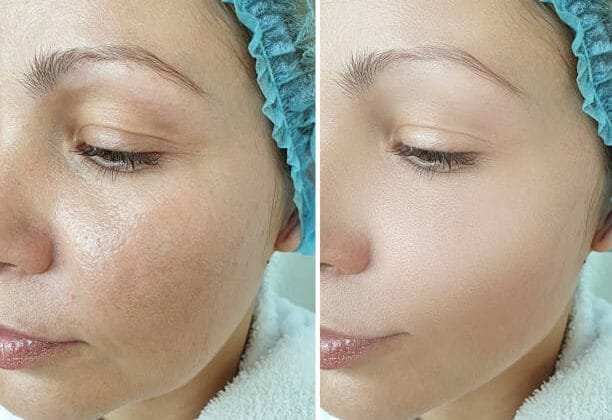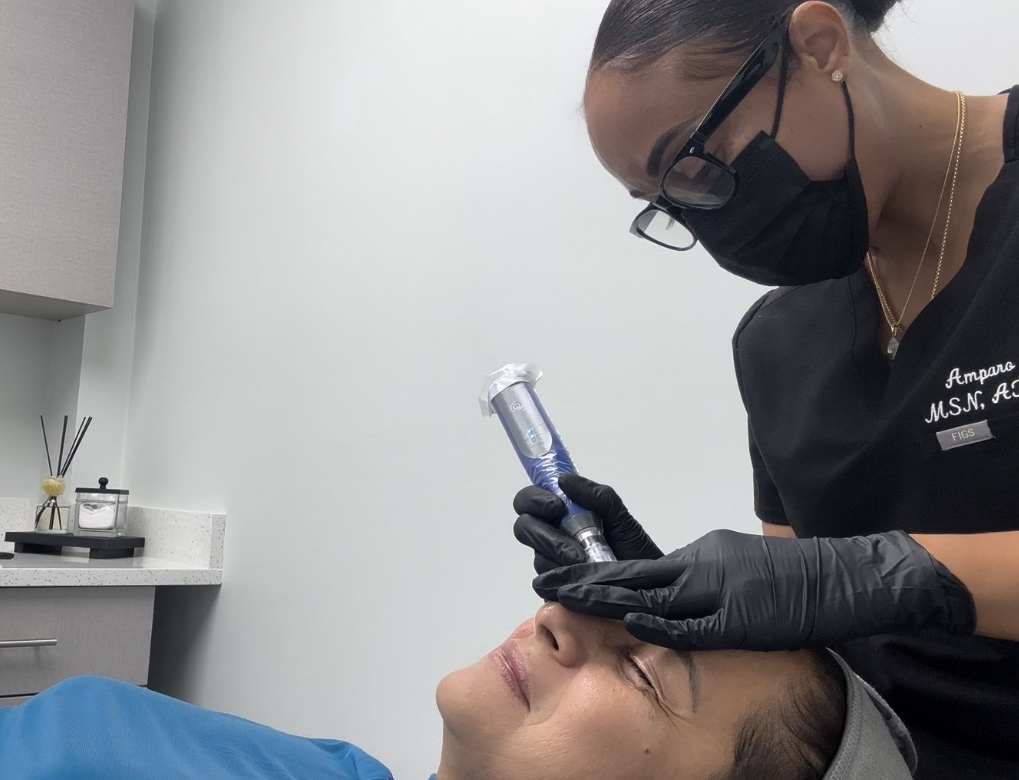Microneedling vs. Dermaplaning: Not sure which skin treatment is right for you? Below you will find the differences between microneedling and dermaplaning, their benefits, and how they can help your skin. Schedule your appointment with Collective Aesthetics.
Blog Post Overview
Here at skinhub, we are trained in the differences between microneedling and dermaplaning. We’ll break down the pros of each, how they work, and which might be a better choice for your skin type and goals. This post will help you determine the right approach if you want smoother, clearer skin, or to reduce fine lines and wrinkles. By the end of this, you will have a better understanding of these procedures and how they might help your skincare regimen.

Microneedling vs. Dermaplaning: What’s the Difference?
Club soda and vinegar, a couple of popular treatments for the freshest, smoothest, glowing-est skin: microneedling and dermaplaning. Both promise to improve skin texture and tone, but they work in different ways. If you are trying to choose between the two, you are not alone. These treatments are frequently compared because they have similar benefits, but in different ways.
In this post, we will discuss the fundamental differences between microneedling and dermaplaning. We’ll also cover how to decide which option is best for your skin’s needs (plus what each treatment can do).
What is Microneedling?
Microneedling, or collagen induction therapy, is a minimally invasive procedure involving tiny needles to create controlled micro-injuries on the skin’s surface. These tiny punctures trigger the body’s natural healing process, stimulating collagen and elastin production. As a result, microneedling can help with various skin concerns, including:
- Fine lines and wrinkles
- Acne scars
- Enlarged pores
- Stretch marks
- Hyperpigmentation
The procedure typically takes 30 to 60 minutes and can be performed on the face, neck, or other body areas. After the treatment, you may experience some redness, similar to a mild sunburn, but this usually subsides within a day or two.
What is Dermaplaning?
Dermaplaning is a noninvasive exfoliation procedure that uses a sterile surgical scalpel to remove dead skin cells and peach fuzz (vellus hair) from the surface of the skin. This technique leaves the skin looking smoother, brighter, and more radiant.
Unlike microneedling, dermaplaning does not involve any needles or invasive procedures. Instead, the scalpel gently scrapes away dead skin cells, providing immediate results in smoother skin and a more even skin tone.
Dermaplaning is ideal for:
- Smoother skin texture
- A more radiant complexion
- Removing dead skin cells
- A quick, noninvasive treatment with no downtime
It’s an excellent option for those looking for a refreshing glow without needing recovery time.

Key Differences Between Microneedling and Dermaplaning
While both treatments are excellent for improving skin texture and tone, there are some key differences to consider.
1. Treatment Technique
- Microneedling: Tinyles are used for micro-injuries in the skin, stimulating costimulation and healing.
- Dermaplaning: A sterile scalpel exfoliates the skin by removing dead skin cells and peach fuzz.
2. Results
- Microneedling: Targets deeper layers of the skin, making it ideal for treating acne scars, fine lines, wrinkles, and hyperpigmentation.
- Dermaplaning: Removing dead skin cells and peach fuzz provides immediate results, leaving your skin looking brighter and smoother.
3. Recovery Time
- Microneedling: May require 24 to 48 hours of recovery time, with redness and slight swelling as common side effects.
- Dermaplaning: Has no downtime. Your skin will feel smoother and more radiant right after the treatment, with no visible signs of redness.
4. Pain Level
- Microneedling: May cause mild discomfort, mainly if numbing cream isn’t used.
- Dermaplaning: Generally painless, though you may feel a light scraping sensation.
5. Ideal Candidates
- Microneedling: Ideal for those looking to treat deeper skin concerns like acne scars, wrinkles, and large pores.
- Dermaplaning: Great for those who want smoother, more radiant skin without addressing deeper skin issues.
6. Frequency of Treatments
- Microneedling: Typically done every 4 to 6 weeks to allow the skin to heal and regenerate collagen fully.
- Dermaplaning: Can be performed every 3 to 4 weeks to maintain smooth, glowing skin.

Microneedling vs. Dermaplaning: Which Treatment is Right for You?
Now that you know the differences between microneedling and dermaplaning, the question is — which is right for your skin? Each includes unique advantages based on your skin type and objectives.
Say you want a treatment that addresses deeper skin concerns such as acne scars or lines. If that sounds like you, microneedling might be best.” This treatment works as it stimulates collagen production in the treated areas over time to enhance overall skin health and appearance.
Dermaplaning, on the other hand, is a great choice if you want a quick, noninvasive treatment that gives you an instant glow. It’s great for smoother skin with no downtime and no invasive procedures.”
Benefits of Microneedling
- Reduces fine lines and wrinkles
- Treats acne scars and other skin imperfections
- Improves skin texture and tone
- Stimulates collagen production for firmer, youthful-looking skin
- Minimal downtime
Benefits of Dermaplaning
- Immediate smoother skin texture
- Brightens the complexion
- Removes dead skin cells and peach fuzz
- No downtime
- Quick, painless procedure
Judgement: Microneedling vs. Dermaplaning – Which is Right for You?
Microneedling and dermaplaning provide distinct benefits for various skin concerns. Let’s say you’re seeking deeper skin rejuvenation and want to tackle things like fine lines, acne scars or enlarged pores. If that’s the case, microneedling might be perfect for you. But for a quick skin refresh that results in a brighter, smoother appearance, dermaplaning is a good call.
We offer both at Collective Aesthetics so you can achieve your skincare goals. If you want the collagen-boosting benefits of microneedling or just a quick, instant glow with a dermaplaning treatment, our team of expert practitioners can help you decide what’s best for your skin.

Contact Information
- Address: 6229 Miramar Pkwy Ste 7, Miramar, FL 33023, United States
- Phone: (305) 528-3360
- Email: info@collective-aesthetics.com
- Website: www.collective-aesthetics.com
- About: About Us
- Consultation: Book A Consultation now!
Related topic for
Microneedling Treatments
- Microneedling in Florida: Benefits, Cost & What to Expect
- Microneedling for Acne Scars: Does It Really Work?
- Microneedling vs. Chemical Peels: Which is Right for You?
- The Science Behind Microneedling: How It Stimulates Collagen Production
- How Often Should You Get Microneedling for Best Results?
- Microneedling Aftercare: What to Do & What to Avoid
- Microneedling with PRP vs. Traditional Microneedling: Which is Better?
- Does Microneedling Help with Stretch Marks?
- Microneedling for Hyperpigmentation: Can It Even Out Skin Tone?
- Microneedling for Hair Growth: Can It Treat Hair Loss?
- Microneedling vs. Laser Resurfacing: Which Is Best for Your Skin?
- Microneedling for Wrinkles & Fine Lines: Anti-Aging Benefits
- At-Home Microneedling vs. Professional Treatments: What’s the Difference?
- How Long Do Microneedling Results Last?
- Is Microneedling Safe? Side Effects & What to Expect
- Microneedling and Botox: Can You Combine These Treatments?
- How to Prepare for Your First Microneedling Session
- Microneedling for Rosacea: Can It Help Reduce Redness?
- Microneedling for Enlarged Pores: Does It Make a Difference?











